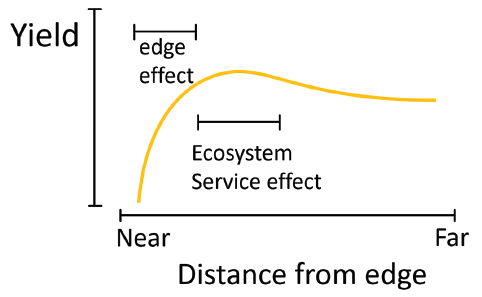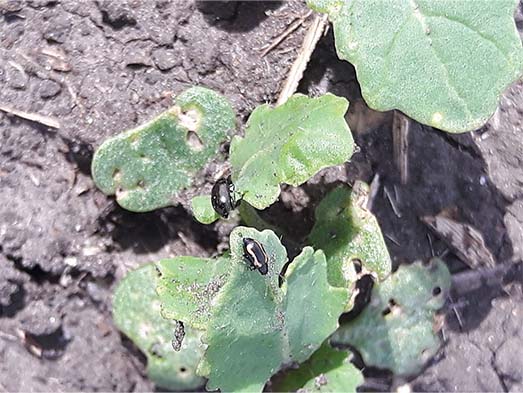Agronomy tips from the Canola Watch webinars
Canola Watch has a new winter webinar series. When we wrote this article, three of the six webinars had been presented. Here are highlights from those three.
WEBINAR 1: GENETICS, ENVIRONMENT AND MANAGEMENT: FINDING ROOM FOR IMPROVEMENT
What drives yield can be divided into three pillars – genetics, environment, and management (GxExM). Record keeping that includes notes on weather and crop staging will help each farm figure out GxExM combinations that work best for them.
“What’s right for your farm isn’t the same as what’s right for your neighbour’s farm,” says Keith Fournier, SaskCanola director and farmer at Lone Rock, Saskatchewan. He was a webinar presenter. “We all have different risk tolerances, we all have different equipment. So find out what works for your farm under your management.”
The GxExM topic relates to phenology, which is the study of crop development and the influence of biotic and abiotic factors, including two big ones – temperature and precipitation.
Some findings from a Canola Council of Canada (CCC) phenology field project in 2021:
- The 2021 growing season had no weather “normals”
- Fields seeded later into warmer soils emerged more quickly. None of the fields emerged faster than seven days after planting.
- When the number of days from bolting to 60 per cent seed colour change (SCC) increased, so did yield.
The CCC has a new phenology tracking sheet for record keeping to capture GxExM trends for each farm. To download the tracking sheet, go to canolacouncil.org/research and scroll to the “Phenology” heading at the bottom. If you missed this webinar, watch all segments at youtube.com/canolacouncil or listen to the podcast at soundcloud.com/whetterj/phenotyping.
WEBINAR 2: TARGETING TRAITS TO IMPROVE YIELD AND CONSISTENCY – UNDERSTANDING THE IMPORTANCE OF TRAITS AND CULTIVAR SELECTION
Don’t grow one cultivar over the entire farm. Take time to choose the right ones.
“Yield lost to incorrect cultivar choice may be a greater risk than yield gained by choosing the highest yielding cultivar,” says Clinton Jurke, CCC agronomy director and webinar presenter. He recommends regular scouting and good record keeping for each field. “When you really understand what’s happening in your fields, you can select which traits that correct those most important yield robbers.”
Errin Willenborg, agronomy strategist with WinField United Canada, says regular scouting in combination with the latest research and extension messaging will help farmers adapt to continuous changes in each field. “Just because you believe something about clubroot or blackleg today, it might not necessarily be true two years or five years from now, so try to stay on top of the research and new extension messaging and try to use that in your hybrid decision making,” Willenborg says.
A few webinar tips to help with seed decisions:
- Genetic resistance should not be our only defense against pests. To protect these genetic tools, include them as one piece of an integrated management strategy.
- “Second generation” clubroot resistance is not inherently better than “first generation.” It depends on the clubroot pathotype population in each field.
- The blackleg yield loss calculator is based on a robust model. Use it. Find it at canolacalculator.ca.
- The new Canola Shatter Ratings, ready for seed purchases this fall, will help growers set expectations and make harvest management decisions for canola genetics.
- All canola cultivars have good yield potential. Look beyond yield when making seed decisions.
This webinar covered a lot of ground. If you missed it, watch all segments at youtube.com/canolacouncil or listen to the podcast soundcloud.com/whetterj/maximizehybridpotential.

Research from Paul Galpern’s lab showed a yield “halo effect” around non-farmed areas. Canola yield was lower immediately beside these areas, but a few metres beyond this margin the researchers observed an increase in crop yield and yield stability compared to the field average.
WEBINAR 3: MESSY FIELDS TO BIGGER YIELDS – UNDERSTANDING WHAT IS HAPPENING IN THE FIELD MARGINS AND SURROUNDING LANDSCAPES OF CROP LAND
Biodiversity has benefits for insect pest management and for overall farm yields. This webinar makes a pitch to maintain (or possibly add to) non-farmed spaces such as shelterbelts, wetlands, fence rows and ditches.
Paul Galpern, associate professor in the Department of Biological Sciences at the University of Calgary, is excited by the possibility for “win-wins” from these spaces – where both farm profitability and environmental sustainability objectives can be achieved at the same time.
Galpern’s lab collected data on hundreds of fields in central Alberta. The research showed a yield “halo effect” around non-farmed areas. Canola yield was lower immediately beside these areas, but a few metres beyond this margin the researchers observed an increase in crop yield and yield stability compared to the field average. “It isn’t going to change profitability to a great degree,” Galpern says. “We didn’t find a big effect, but we found some effect.”
Part of the yield bump could come from the insect-managing biodiversity these areas provide. “Retain these messy areas in your fields, add more maybe, because they keep natural enemies and pollinators close to your fields,” Galpern says.
Héctor Cárcamo, research scientist and insect pest management specialist with Agriculture and Agri-Food Canada in Lethbridge, Alberta, also participated in the webinar. Cárcamo gave two good reasons to make insect management decisions based on thresholds. Reason one: “If you only have a few insects, you can actually have a boost in yield,” Cárcamo says. Plants are shown to produce more seed yield when stimulated by a small amount of insect feeding. Reason two: Spraying only after pest counts exceed their thresholds will eliminate some sprays. These eliminated sprays will help protect the whole insect ecosystem – including the beneficial insects marching out of non-farmed spaces to lend a hand.
If you missed this webinar, watch all segments at youtube.com/canolacouncil or listen to the podcast soundcloud.com/whetterj/biodiversityandinsects.
Flea beetles: Management update
Flea beetles remain the most common insect pest of Western Canadian canola. They are also the least predictable. Local areas across the Prairies see damaging levels of feeding each spring. Here are few tips that can improve crop establishment and limit flea beetle damage:
- Achieve good residue management at harvest
- Upgrade insecticide seed treatment for flea beetles
- Use only safe rates of seed-placed phosphate fertilizer
- Maintain an adequate seeding rate to achieve five to eight plants per square foot
- Seed into a warm, moist seedbed
- Check depth and seeder performance regularly
- Scout frequently in warm dry conditions or where feeding is of concern
Seeding shallow, at a reduced speed, into a warm moist seedbed can reduce flea beetle concerns. These steps help the crop emerge quickly and grow rapidly through the cotyledon to four-leaf stages that are highest risk for feeding injury. Emergence rates under these conditions are well above the typical 50 to 60 per cent.

When a field has five to eight canola plants per square foot and those plants grow rapidly to the four-leaf stage, flea beetle damage is more likely to stay below the action threshold, which is 25 per cent leaf area loss.
While seedbed conditions are somewhat out of the grower’s control, growers can control the seeding job to maximize emergence and increase seedling vigour. Anything that increases emergence can help with flea beetle management. For example: Ensure your drill is consistently placing seeds at 0.5 to one inch depth. Consider increasing the seeding rate on fields with challenging emergence conditions. Reduce seedplaced fertilizer. Seed later when soils are typically warmer or even delay seeding to wait for improved moisture conditions.
For more flea beetle management tips, read the Agronomy Insight article from the September 2021 Canola Digest at canoladigest.ca and read the Flea Beetles chapter in the Insects section at canolaencyclopedia.ca.





